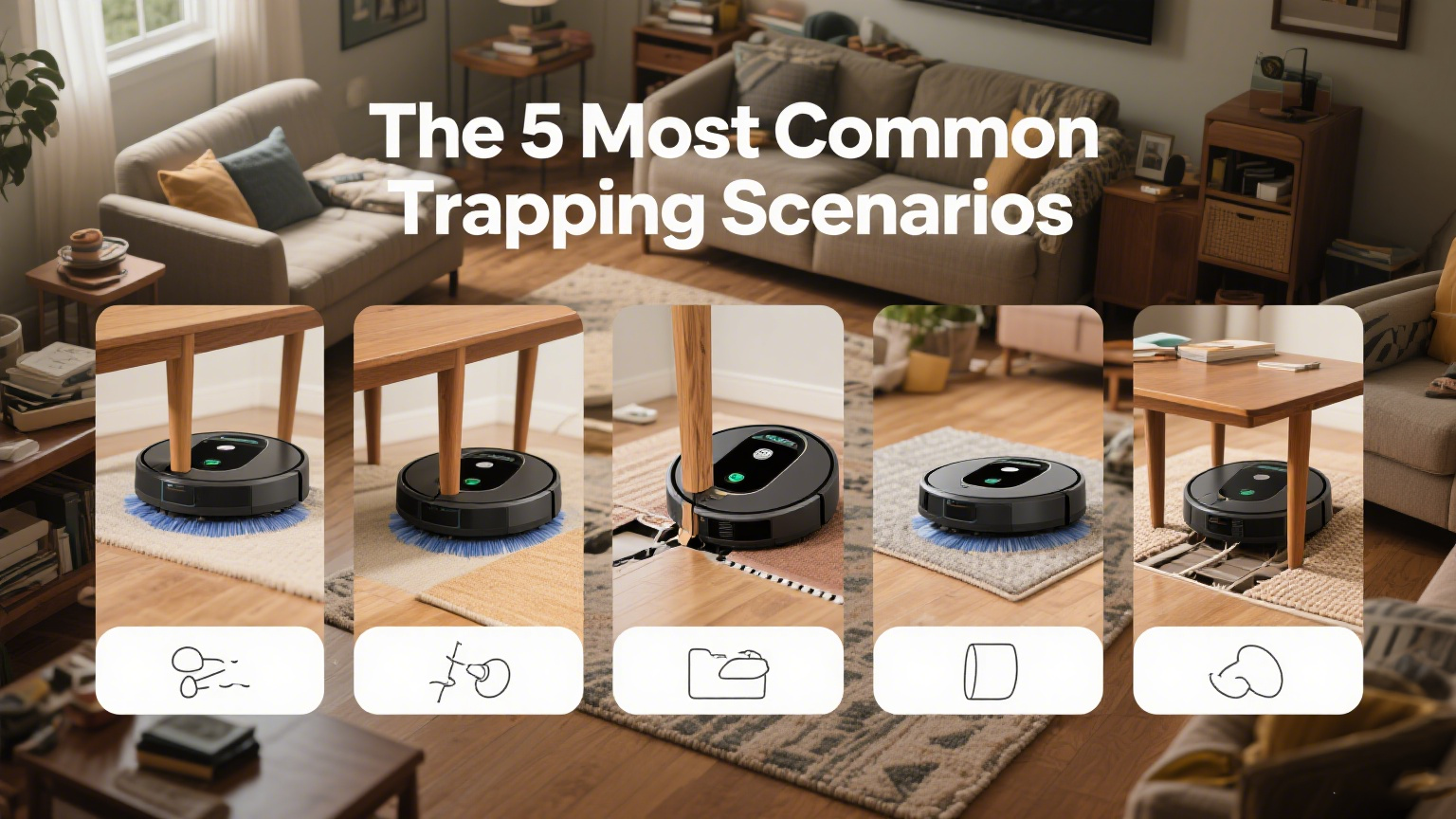Your robot vacuum keeps getting stuck? and you're tired of playing rescue mission every time it cleans. I've seen every possible
way they can get trapped. The good news? Most issues have simple solutions that don't require technical expertise.
Why Does My Robot Vacuum Keep Getting Stuck?
Understanding why your robotic helper gets stuck is the first step to solving the problem permanently.
Last year, one of our clients returned 50 units claiming they were defective. After testing, we discovered 90% were working perfectly -
they were just being used in environments with obstacles the buyers hadn't considered. This experience taught me that most "malfunctions"
are actually user environment issues.
The 5 Most Common Trapping Scenarios
The Furniture Trap
Low-clearance furniture like sofas and cabinets
Typical clearance needed: 3.5-4 inches (varies by model)
Solution: Measure your furniture and compare to vacuum height
The Cord Chaos
Phone chargers, lamp wires, and blind cords
Creates both physical blockages and sensor confusion
Solution: Implement a pre-cleaning cord check routine
The Threshold Trouble
Doorway transitions higher than 0.6 inches
Uneven flooring between rooms
Solution: Use transition ramps or adjust cleaning zones
The Carpet Conundrum
High-pile carpets (over 0.5 inch)
Fringe edges on area rugs
Solution: Use boundary strips or select high-clearance models
The Black Hole Effect
Dark-colored floors confusing cliff sensors
Shiny surfaces that reflect IR beams inaccurately
Solution: Test in different lighting conditions
Sensor Performance by Price Tier
Price Range | Sensor Accuracy | Stuck Prevention Features |
$100-$200 | Basic IR only | Minimal obstacle detection |
$200-$400 | Improved IR + bump | Basic object avoidance |
$400+ | LiDAR + camera | Advanced mapping & avoidance |
![Why Does My Robot Vacuum Keep Getting Stuck?]()
How to Prevent My Robot Vacuum from Getting Stuck?
Prevention is always better than troubleshooting. Here's how to robot-proof your home.
Step-by-Step Environment Preparation
Pre-Cleaning Walkthrough
Do a quick scan of cleaning areas
Pick up small items like socks and toys
Secure loose cables with adhesive clips
Furniture Adjustments
Raise low-clearance furniture with risers
Install magnetic boundary strips under problem areas
Consider replacing thick area rugs with low-pile alternatives
Lighting Considerations
Ensure consistent lighting during cleaning cycles
Avoid direct sunlight that can blind sensors
Use night mode if available for dark rooms
Maintenance Schedule for Optimal Performance
Frequency | Task | Impact on Stuck Prevention |
Daily | Quick visual inspection | Prevents 30% of issues |
Weekly | Full sensor cleaning | Maintains 90% detection |
Monthly | Wheel and brush maintenance | Ensures proper movement |
Quarterly | Full system diagnostic | Catches developing issues |
![Why Does My Robot Vacuum Keep Getting Stuck? How to Prevent My Robot Vacuum from Getting Stuck?]()
Advanced Troubleshooting for Persistent Problems
When basic fixes don't work, it's time to dig deeper.
Software Solutions Worth Trying
Map Optimization
Redraw no-go zones with tighter boundaries
Adjust cleaning paths to avoid problem areas
Create virtual barriers around persistent traps
Firmware Updates
Check manufacturer's website monthly
Update navigation algorithms
Patch known sensor issues
Cleaning Pattern Adjustment
Switch from random to systematic cleaning
Reduce cleaning speed in problematic areas
Increase overlap percentage for better coverage
Hardware Modifications (For Tech-Savvy Users)
Wheel Extensions
Add 0.5cm risers for better clearance
Install all-terrain wheels for uneven surfaces
Sensor Enhancements
Apply anti-reflective coating to sensors
Add supplemental IR emitters for dark areas
Bumper Upgrades
Install wider contact sensors
Add protective bumpers to prevent wedging
![Advanced Troubleshooting for Persistent Problems]()
When to Consider a Replacement
Sometimes, an upgrade is the most practical solution.
Signs You Need a New Model
Frequent Stuck Incidents (More than 2-3 per cleaning cycle)
Outdated Technology (Lacking modern navigation features)
Physical Damage (Bent chassis or sensor array)
Unavailable Parts (For critical repairs)
Feature Comparison for Stuck Prevention
| Feature | Entry-Level | Mid-Range | Premium |
LiDAR Navigation | ❌ | ✔️ | ✔️ |
3D Object Avoidance | ❌ | ❌ | ✔️ |
Auto Height Adjust | ❌ | ✔️ | ✔️ |
AI Mapping | ❌ | ❌ | ✔️ |
Multi-Floor Memory | ❌ | ✔️ | ✔️ |
Final Thoughts
Persistent robot vacuum getting stuck issues usually stem from three factors: environment challenges, maintenance neglect,
or technological limitations. By systematically addressing each potential cause - from simple cord management to considering an
upgrade with better sensors - you can dramatically reduce frustration and keep your automated cleaner running smoothly.
Remember that prevention is key. A few minutes of preparation before each cleaning cycle can save hours of troubleshooting.
For wholesale buyers, these insights can also help you select better models for your customers' specific home environments.















